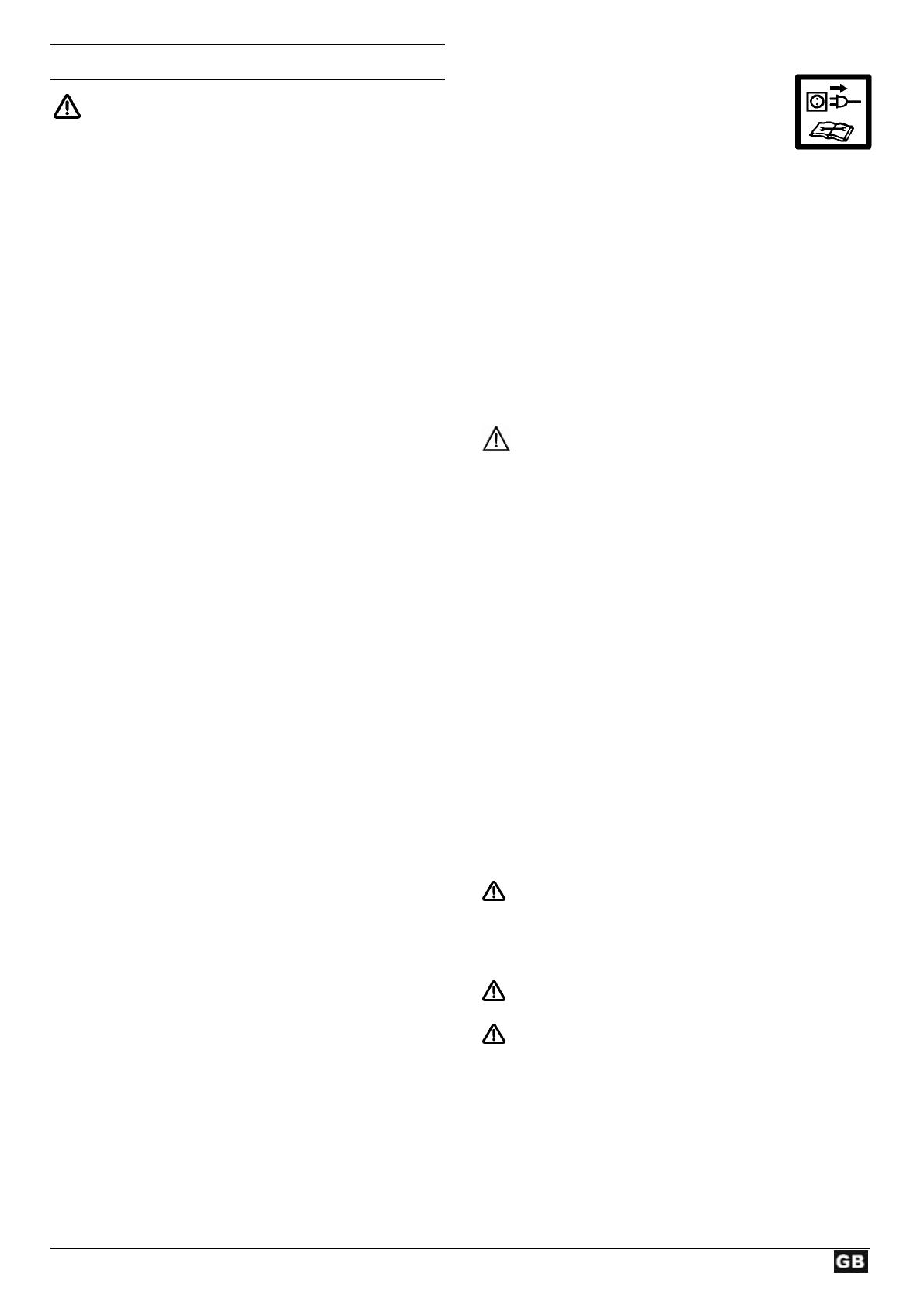
12
S
S
a
a
f
f
e
e
w
w
o
o
r
r
k
k
i
i
n
n
g
g
Before commissioning this product, read and keep to
the following advice. Also observe the preventive regulations
of your professional association and the safety provisions
applicable in the respective country, in order to protect
yourself and others from possible injury.
L
Pass the safety instructions on to all persons who work
with the machine.
L
Keep these safety instructions in a safe place.
Make yourself familiar with the equipment before using it, by
reading and understanding the operating instructions.
Do not use the machine for unsuitable purposes (see “Normal
intended use” and “Working with the log splitter”).
Ensure that you have stand in a secure standing position
and maintain your balance at all times.
Take a working position, which is behind the slide of the
area of the operating lever. Never stand in the splitting
wedge’s zone.
Never stand on top of the machine.
Pay attention at all times. Take care with what you are doing,
and approach the work sensibly. Do not use the machine:
− when you are tired.
− under the influence of drugs, alcohol or medications that
may impair your powers of judgement.
When working with the machine, always wear
− protective goggles or face mask
− safety gloves
− ear protection, if necessary
− safety shoes with steel toe-caps
Wear suitable work clothing:
− do not wear any loose-fitting clothing or jewellery, since
these may be caught or trapped by moving parts
Within his area of work the operator is responsible for third
parties.
The machine may not be operated by children or young
people under the age of 18.
Keep children away form machine.
Never operate the machine if other persons are in the
immediate vicinity.
Never leave the saw unattended.
Keep your workplace in an orderly condition! Untidiness
can result in accidents.
Do not overload the machine! You work better and safer in
the given performance range.
Only operate the machine with complete and correctly
attached safety equipment and do not alter anything on the
machine that could impair the safety.
Faulty or damaged parts in the device must be replaced
immediately.
Do not spray machine with water
(this is hazardous due to live components).
Do not leave the machine standing in the rain or use when
raining.
Store the unused machine in a dry locked place away from
the reach of children.
Switch the machine off and remove the mains plug from the
socket when
− carrying out repair works
− carrying out servicing and repair works,
removal of faults
− Transporting
− leaving unattended (even during short interruptions)
Check the machine for possible damage
− Before continuing to use the machine, the protective
devices must be inspected to ensure that they work
perfectly and with their intended function
− Check whether the parts are damaged. All parts must be
correctly installed and fulfil all conditions to ensure perfect
operation of the saw
− Damaged guards and parts must be properly repaired or
exchanged by a recognized, specialist workshop; insofar
as nothing else is stated in the instructions for use.
− Damaged or illegible safety warning labels should be
replaced immediately.
Electrical safety
Electrical connections must conform to IEC 60245 (H 07
RN-F) with a cable cross-section of at least
⇒ 2.5 mm² for a maximum cable length of up to 10 m
Never use the machine with a power supply cable of over 10
m in length. Longer power supply cables will cause a drop in
voltage. The motor will not be able to provide its maximum
performance and the operation of the machine will be
impaired.
When laying the connecting attachments, be sure that they
do get crushed or bent, and that the plug-and-socket
connection does not get wet.
Do not use the cable for purposes for which it is not meant.
Protect the cable against heat, oil and sharp edges. Do not
use the cable to pull the plug from the socket.
Regularly check the extension cables and replace them if
they are damaged.
Do not use any defective connection cables.
When working outdoors, only use extension cables especially
approved and appropriately labelled for outdoor use.
Do not set up any provisional electrical connections.
Never bypass protective devices or deactivate them.
The electrical connection or repairs to electrical parts of
the machine must be carried out by a certified electrician or
one of our customer service points. Local regulations –
especially regarding protective measures – must be
observed.
Repairs to other parts of the machine must be carried out
by the manufacturer or one of his customer service points.
Use only original spare parts, accessories and special
accessory parts. Accidents can arise for the user through
the use of other spare parts. The manufacturer is not
liable for any damage or injury resulting from such action.








